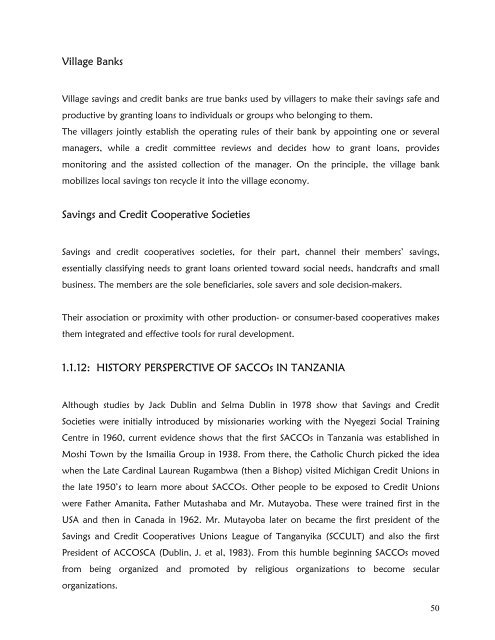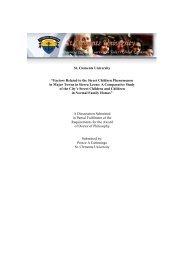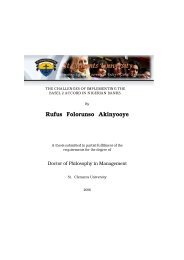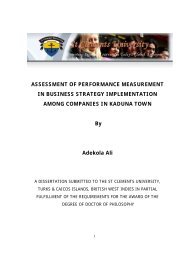The role of informal microfinance institutions in saving
The role of informal microfinance institutions in saving
The role of informal microfinance institutions in saving
Create successful ePaper yourself
Turn your PDF publications into a flip-book with our unique Google optimized e-Paper software.
Village Banks<br />
Village sav<strong>in</strong>gs and credit banks are true banks used by villagers to make their sav<strong>in</strong>gs safe and<br />
productive by grant<strong>in</strong>g loans to <strong>in</strong>dividuals or groups who belong<strong>in</strong>g to them.<br />
<strong>The</strong> villagers jo<strong>in</strong>tly establish the operat<strong>in</strong>g rules <strong>of</strong> their bank by appo<strong>in</strong>t<strong>in</strong>g one or several<br />
managers, while a credit committee reviews and decides how to grant loans, provides<br />
monitor<strong>in</strong>g and the assisted collection <strong>of</strong> the manager. On the pr<strong>in</strong>ciple, the village bank<br />
mobilizes local sav<strong>in</strong>gs ton recycle it <strong>in</strong>to the village economy.<br />
Sav<strong>in</strong>gs and Credit Cooperative Societies<br />
Sav<strong>in</strong>gs and credit cooperatives societies, for their part, channel their members’ sav<strong>in</strong>gs,<br />
essentially classify<strong>in</strong>g needs to grant loans oriented toward social needs, handcrafts and small<br />
bus<strong>in</strong>ess. <strong>The</strong> members are the sole beneficiaries, sole savers and sole decision-makers.<br />
<strong>The</strong>ir association or proximity with other production- or consumer-based cooperatives makes<br />
them <strong>in</strong>tegrated and effective tools for rural development.<br />
1.1.12: HISTORY PERSPERCTIVE OF SACCOs IN TANZANIA<br />
Although studies by Jack Dubl<strong>in</strong> and Selma Dubl<strong>in</strong> <strong>in</strong> 1978 show that Sav<strong>in</strong>gs and Credit<br />
Societies were <strong>in</strong>itially <strong>in</strong>troduced by missionaries work<strong>in</strong>g with the Nyegezi Social Tra<strong>in</strong><strong>in</strong>g<br />
Centre <strong>in</strong> 1960, current evidence shows that the first SACCOs <strong>in</strong> Tanzania was established <strong>in</strong><br />
Moshi Town by the Ismailia Group <strong>in</strong> 1938. From there, the Catholic Church picked the idea<br />
when the Late Card<strong>in</strong>al Laurean Rugambwa (then a Bishop) visited Michigan Credit Unions <strong>in</strong><br />
the late 1950’s to learn more about SACCOs. Other people to be exposed to Credit Unions<br />
were Father Amanita, Father Mutashaba and Mr. Mutayoba. <strong>The</strong>se were tra<strong>in</strong>ed first <strong>in</strong> the<br />
USA and then <strong>in</strong> Canada <strong>in</strong> 1962. Mr. Mutayoba later on became the first president <strong>of</strong> the<br />
Sav<strong>in</strong>gs and Credit Cooperatives Unions League <strong>of</strong> Tanganyika (SCCULT) and also the first<br />
President <strong>of</strong> ACCOSCA (Dubl<strong>in</strong>, J. et al, 1983). From this humble beg<strong>in</strong>n<strong>in</strong>g SACCOs moved<br />
from be<strong>in</strong>g organized and promoted by religious organizations to become secular<br />
organizations.<br />
50
















